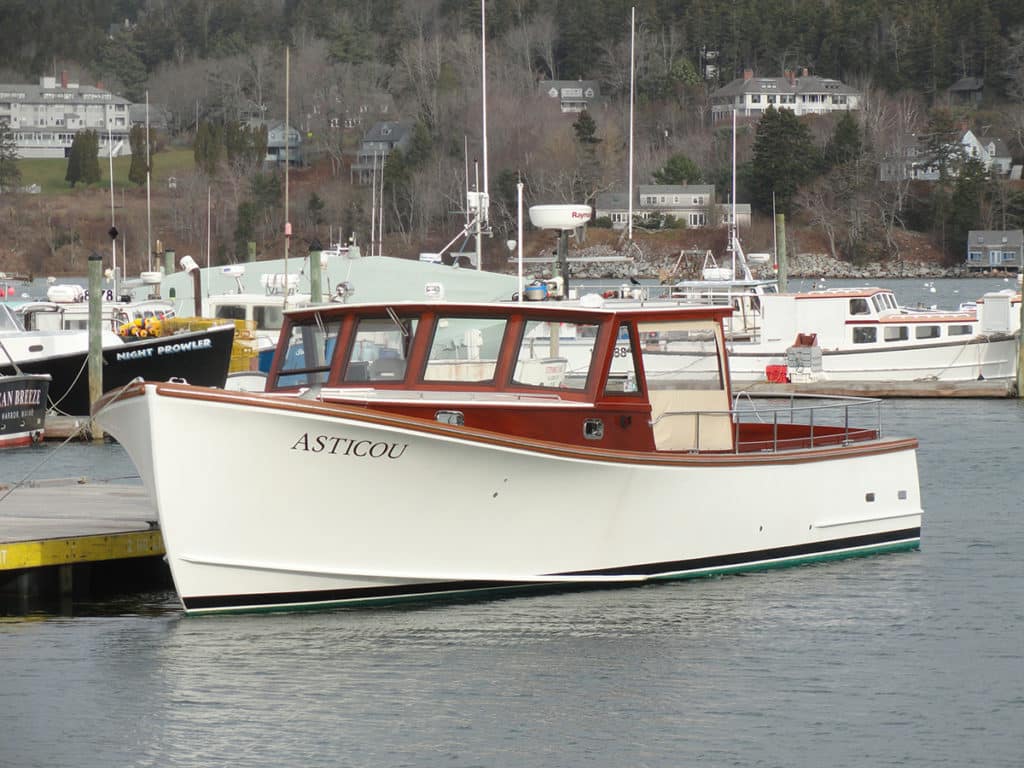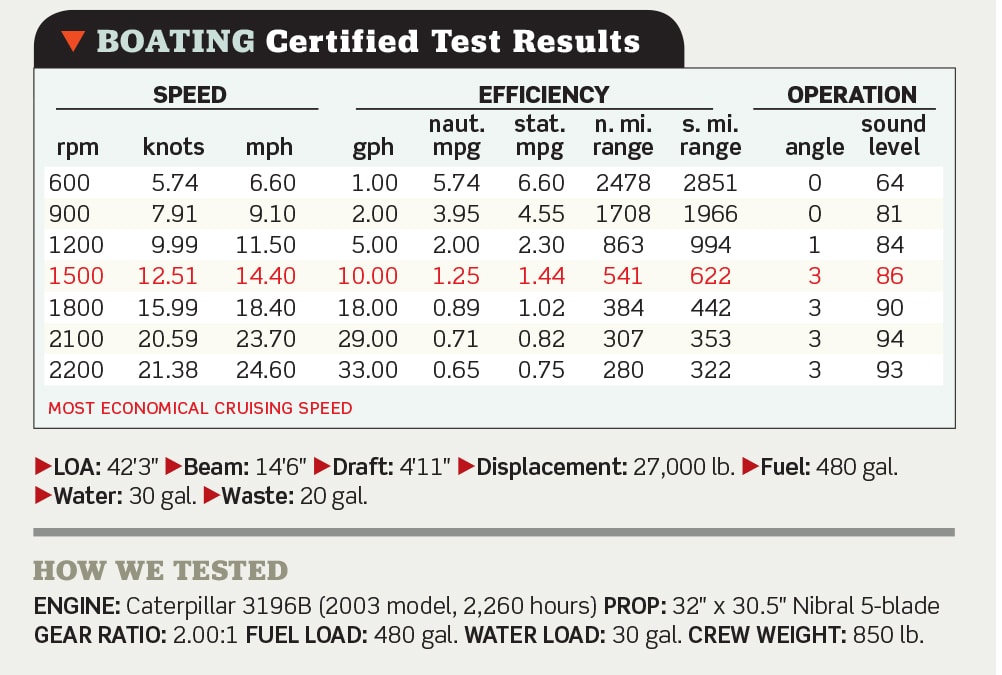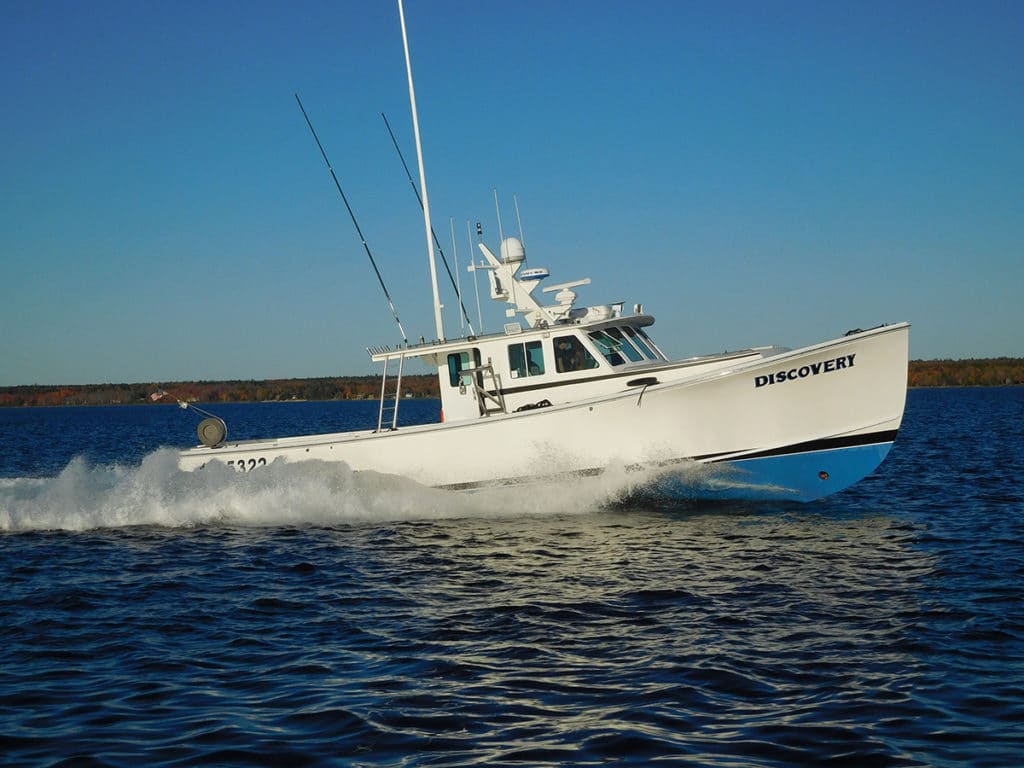
Downeasters, aka lobsterboats, are renowned for their seakeeping ability and classic, thrifty, Yankee good looks. Bred in Maine a century ago, they serve as cruisers, sport-fishers and workboats of all types around the world.
Like any good idea, though, lobsterboats haven’t remained static. They have evolved into subsets of successful local hull forms as developments in propulsion and the needs of boaters have changed. Right now, we are on the cusp of a new evolution of Downeasters.
Just what is the history of the Downeaster? What characteristics have made it so enduring? And how has it changed? To find out, we headed to Wesmac Custom Boats, a premier Downeast boatbuilder in Surry, Maine, that is creating a new “hybrid” design that takes what might be the most venerable and recognized boat type in the world to the next level.
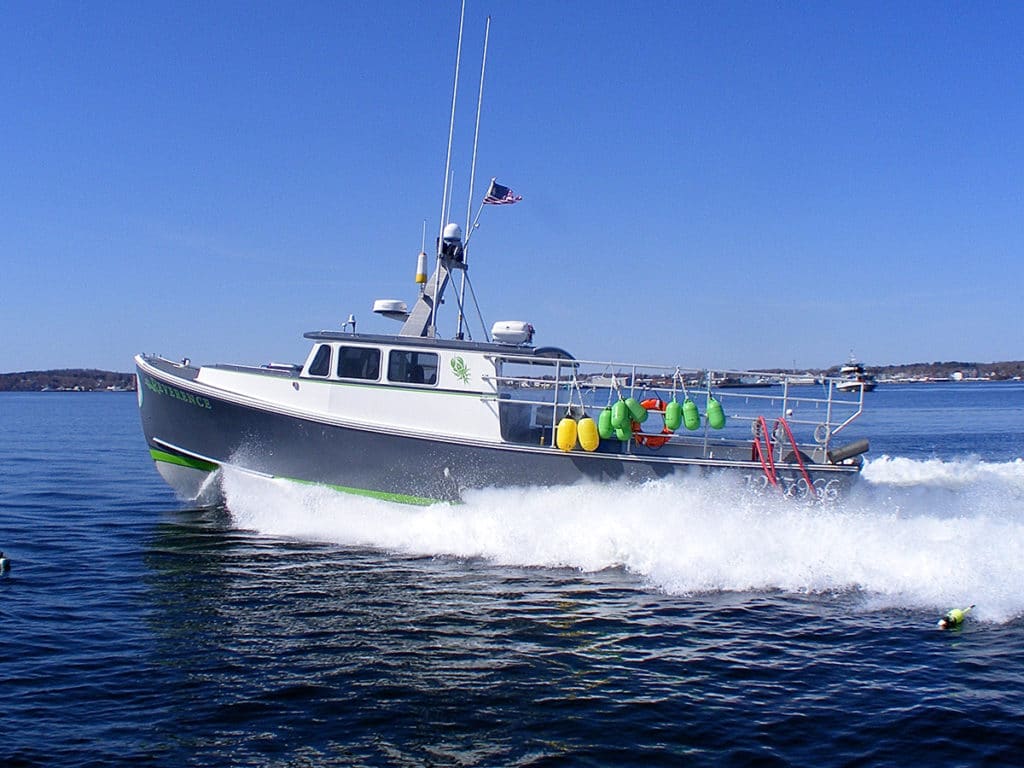
Roll Control
But wait — aren’t Downeast “lobster yachts” slow, and don’t they roll a lot? Well, yes, some of the built-down, full-keel boats with rounded chines of the 1950s, ’60s, and ’70s fit that description. This hull design evolved from sailboats. Designed for the 150 to 225 hp diesels of that era, these semi-displacement hulls efficiently make speeds in the mid-teens for working fishermen and former cruising sailors switching to power. Their owners love the seakindly motion, good balance and maneuverability. The lighter “skeg boats” from Beals Island and Jonesport, with their bolted-on keels and flat bottoms aft, can lift onto full plane and run faster. They led the way in the developing lobsterboat racing circuit, most of them running souped-up, big-block gas V-8 engines. In the late ’80s, builders looking for more speed began placing full-length spray rails along their hulls’ round chines to increase lift and reduce wetted surface friction.
Meanwhile, former fisherman and workboat broker Steve Wessel and then-partner Mac Pettegrow (the originators of the Wesmac brand) began finishing other builders’ hulls in a shop in Surry. Experienced on the water and knowledgeable about boat design, they quickly developed a reputation for top-grade workmanship. Around 1987, a retired engineer from the Chesapeake Bay’s Rappahannock River asked them to develop a hull that blended the hard chines of the fast Chesapeake-style deadrise hulls with the best characteristics of the built-down and skeg-built hulls.
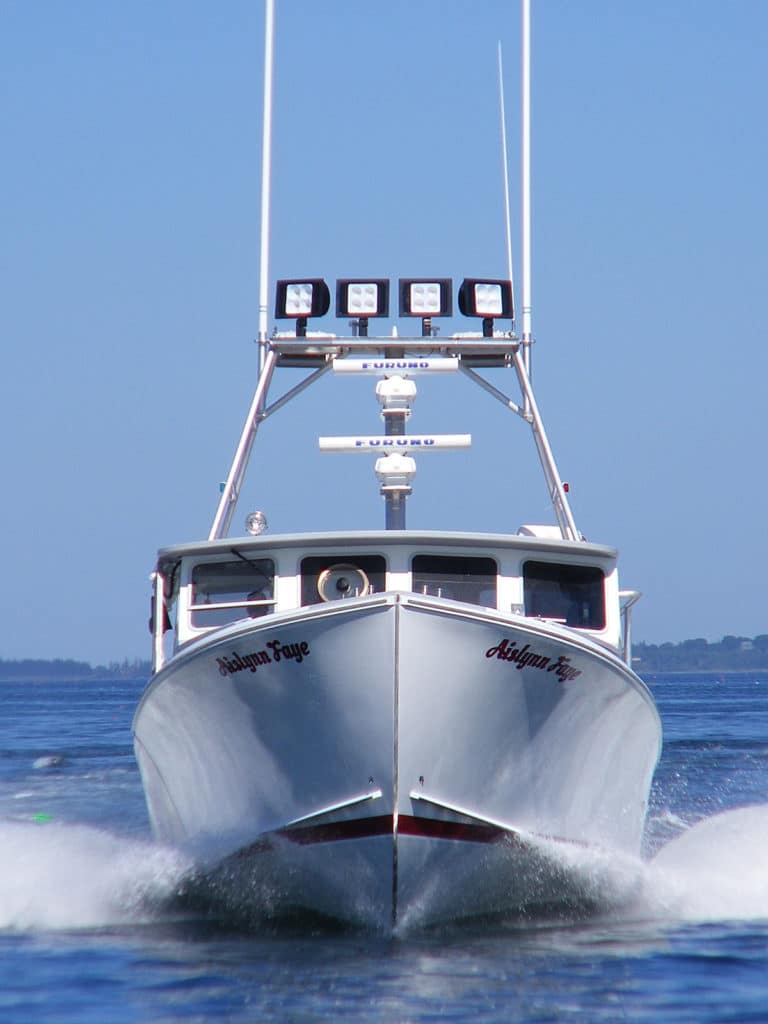
They developed a 42-foot-long, 14-foot-6-inch-wide, full-keel, warped-V hull with a Downeast spoon bow and a sharp entry that tapers to a deep, full forward section and a straight, nearly flat run aft. The new design combined full-length, squared-off, molded-in hard chines with the hull volume to carry a large single engine well forward and low, providing good stability and a shallow propeller shaft angle for efficiency. That hull’s pleasing sheer line includes broad flare at the bow. As it flows astern, the sheer rises slightly in the after third to mimic the tuck-in at the transom where the hull narrows slightly. Modest tumblehome at the stern quarters and a curved transom make the aft end of the boat too slippery for nasty following seas to push around. The forward third of the chines have rails fastened and bonded on to add spray-damping. The keel is an integral feature in the hull’s mold, as with a built-down hull, but its upper edges make sharp angles with the bottom on each side like skeg-built and Chesapeake deadrise hulls.
The resulting hybrid is a classically pretty shape with a clean bottom that rises onto plane easily and runs slightly bow-proud, cleaving seas, shouldering them aside and throwing them cleanly outward. Wesmacs sail easy and run fast. “There’s no frustration underneath,” says Capt. Rick Savage, a Northeast Harbor, Maine, charter skipper who finished off his 42-footer, Asticou, in 2003 and has run it with clients ever since. “It rides easy, with a clean flow of water to the propeller around the carefully molded skeg. It’s also very stable — a valuable characteristic in my business, since people in my charter parties don’t always have good sea legs.”
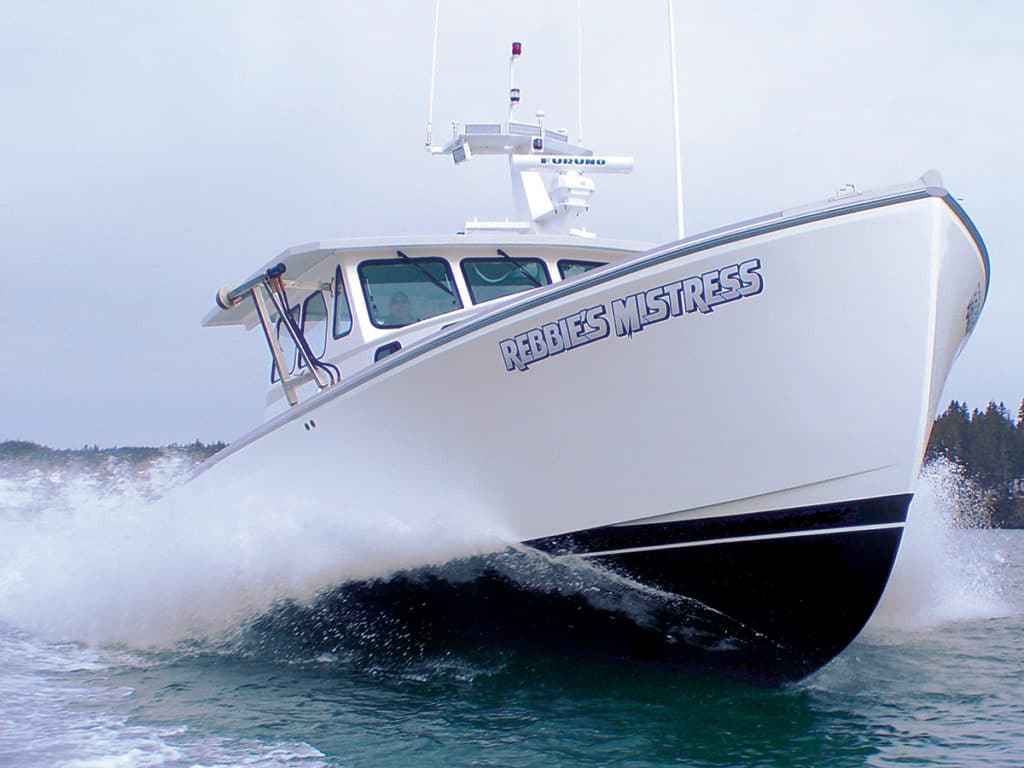
Popularity Contest
That hybrid design has proved so successful that Wesmac is running at flank speed to satisfy demand. In fact, even the boss’s wife can’t get a new boat. She’s Linda Greenlaw, whose name you’ll recognize from The Perfect Storm and her own books, among them The Hungry Ocean and All Fishermen Are Liars. Linda serves as delivery captain and top salesperson for Wesmac, which she owns with her husband, Steve Wessel, and she fishes a small string of lobster traps in Blue Hill Bay.
The only trouble is that the former job works against the latter: Linda has been trying to acquire a new Wesmac to get to her traps faster and to carry more gear than the older boat. Sure, she gets her name on the build list, but by the time her new boat is half-finished, a customer comes along and buys it. Right now, there’s a two-year wait for a new, completed vessel. In addition, demand for the company’s standard 46-foot hull is so high that Wesmac contracts with Front Street Shipyard to have the hulls laid up in the latter’s satellite Bucksport shop.
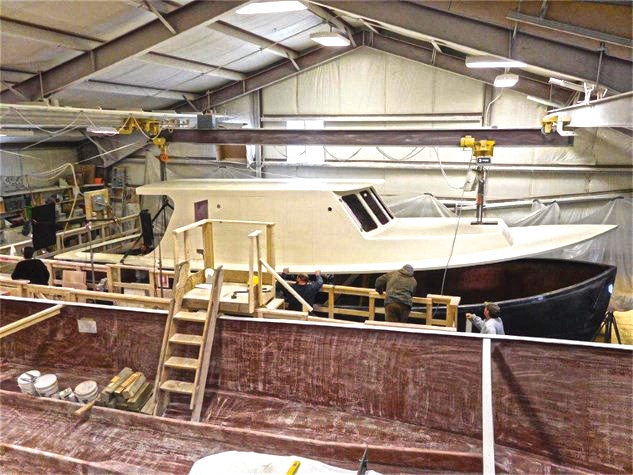
Big boats like these aren’t cheap. So what drives this kind of demand? The current high prices for lobster, abundant stocks of that signature Maine crustacean and low fuel prices allow Downeast fishermen to look for big, fast boats that can cover lots of water and carry the catch in large live tanks.
The enduring factors, though, are that Wesmac’s boats adapt well to a wide range of uses that extend way beyond lobsters. Over the past 32 years, Steve and his crews have built more than 600 vessels. Some have gone to university research laboratories, law enforcement/search-and-rescue agencies, harbor pilots, and a wide range of different commercial fisheries. Others are Coast-Guard-inspected to carry over six passengers for hire, including Asticou, which we sea-trialed, and the new mail boat for Linda’s much-loved Isle au Haut, as well as fishermen and yacht-grade family cruisers around the globe.
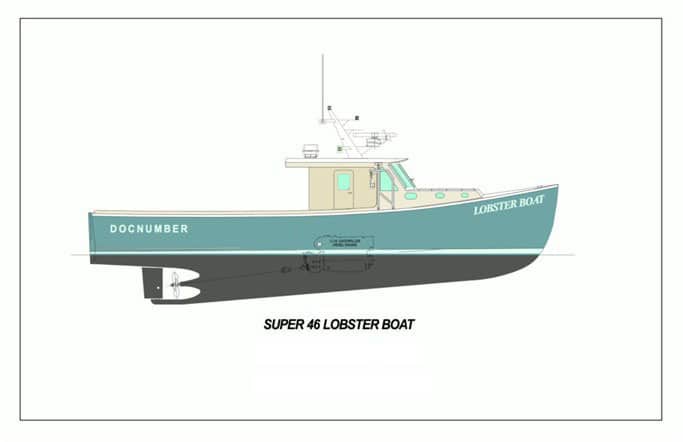
Meet the Fleet
Today, the Wesmac fleet has grown to include a 36 with a 12-foot-8-inch beam that can be lengthened to 38, the original 42 with a 14-foot-6-inch beam that can grow to 46, the new hot seller Super 46 with a 17-foot-1-inch beam, and a 50 with a 17-foot-6-inch beam that can stretch to 60 feet. Each carries the basic hybrid shape of its sisters. The Super 46 hull now even has a pair of lifting strakes on its bottom. Steve and his crew have carefully kept up with advances in composite materials, so options include solid glass or coring (both synthetic foam and balsa) in the bottom and/or topsides, Durakore (balsa) plank or spruce stringers (carefully encapsulated in fiberglass), vinylester or polyester resin, and even DuPont Kevlar cloth in the lay-up. The lamination shop also produces some standard parts with decks: a lobster top, a sport top and a cruiser top.
Every hull is “stick-built,” says Wesmac’s general manager, Bill Grindle, to the customer’s desires. “The first steps in any new boat are thorough conversations with the prospective owners,” says Grindle. “Steve has now built over 600 boats. He and Linda have so much experience on the water that they can help the customer work out the details that make a good boat great.”
The company’s crew includes craftsmen with skills that range from robust hull lay-up and engine installation to finish cabinetwork and pipework.
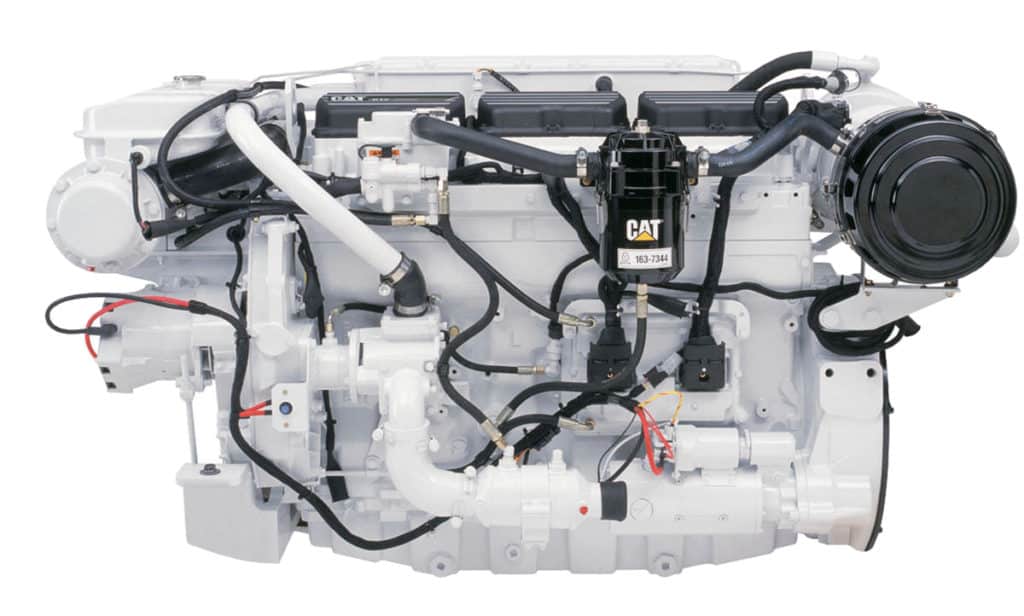
Now enter a new era of electronic, common-rail diesels. They began to come into the fishery in the ’80s and to lobsterboat racing in the ’90s, but the 21st century brought a whole new generation of 600 to 1,925 hp high-performance diesels that fit easily into Wesmac engine bays. Today, most Wesmacs get Caterpillars, ranging from 800 hp C12s to 1,150 hp C18s, but a few have gotten large FPTs and MANs. Currently the shop is installing a C32 Cat of 1,925 hp in a custom 55-foot vessel. The days of mid-teen speeds have largely gone by. A recent 46-foot sport-fisherman, Tuf Guy, topped out at 32 knots during sea trials with Linda.
Not every owner needs that kind of speed or fuel burn. Let’s go back to Asticou. Its engine is a 2003 Cat 3196B, an early electronic version of today’s C12. It makes 660 hp, and with 2,260 hours on it when we visited it and Savage last fall, this durable Cat will probably outlast him. It suits the way he uses his boat very well. In our sea trial, it cruised easily, with a lovely, flat wake at 16.1 mph (1,600 rpm, 39 percent engine load) and a fuel burn of 11 gph. We had only five people aboard then, but Savage says that on whale-watching trips with 20 clients aboard, Asticou makes the 21-nautical-mile run out to Mount Desert Rock in 90 minutes, burning less than 20 gallons of fuel. For a boat that displaces 27,000 pounds, that’s sailing easy.
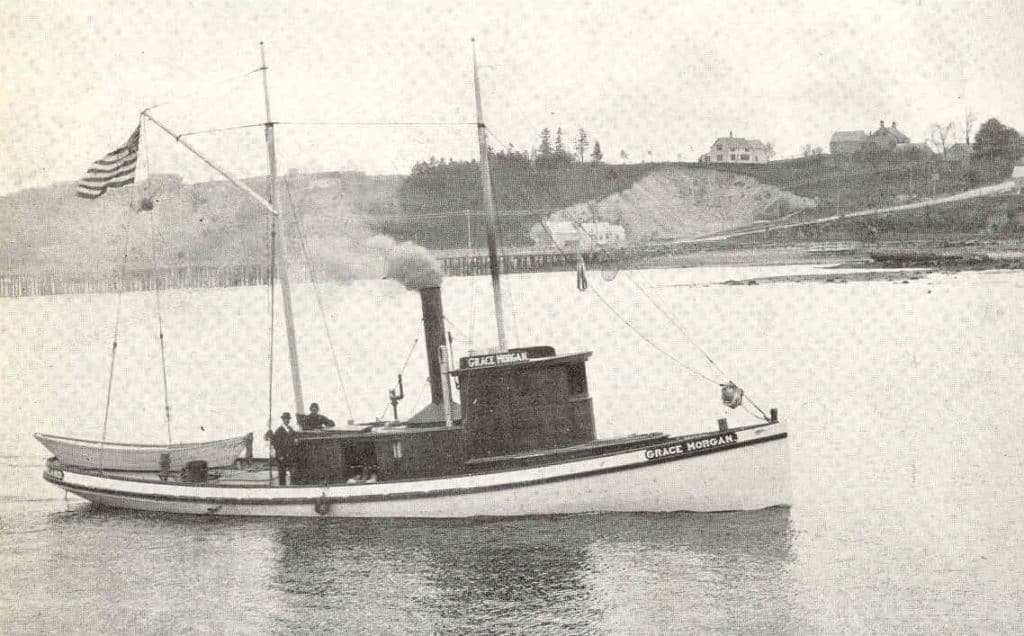
So what is the future of Wesmac Custom Boats? “We’ll keep on building what our customers ask for,” says Steve with a smile. “We love our hybrid hull designs, we know what materials, power and rigging work well in the fleets we serve, and we always love the challenge of finding new ways to do something better — whether it’s fishing, cruising or research.”
“And we’ll keep on making them safe,” adds Linda. “I know what it means to have confidence in your boat when you’re offshore, and Wesmacs inspire it. Obviously you think I’m prejudiced, but I had run several Wesmacs before Steve and I met. I knew the boats before I ever knew the man. And now I love ’em both.”
